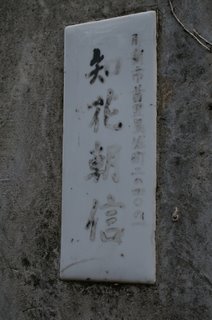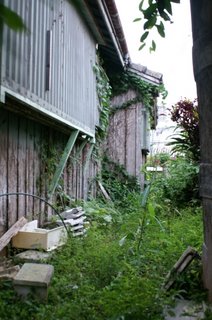Tadaima!
 After nearly a week long sojourn to the birthing grounds of karate, I have returned a bit jet-lagged, tired, but overall a happy person. My research, however, did not go as well as I hoped it would. Mrs. Chibana, some 90 years old today, is in a prefectural nursing home, suffering from advanced Alzheimers along with another ailment where she is unable to breathe properly. She is in a quasi-vegetative state and recognizes no one. My instructor, whom she had treated like a son, was visibly hurt reporting the information to me. Mr. Masahiro Nakamoto, whom I would later meet, was also very saddened when he had given the news to my instructor.
After nearly a week long sojourn to the birthing grounds of karate, I have returned a bit jet-lagged, tired, but overall a happy person. My research, however, did not go as well as I hoped it would. Mrs. Chibana, some 90 years old today, is in a prefectural nursing home, suffering from advanced Alzheimers along with another ailment where she is unable to breathe properly. She is in a quasi-vegetative state and recognizes no one. My instructor, whom she had treated like a son, was visibly hurt reporting the information to me. Mr. Masahiro Nakamoto, whom I would later meet, was also very saddened when he had given the news to my instructor.Mr. Katsuya Miyahira suffered a stroke last fall and is still in a clinic recovering; Mrs. Miyahira is also in the hospital. Outcomes for both are unknown. The Miyahira dojo has been closed since his stroke (understandably so since the dojo is at his home), and we were unable to even at the very least visit and observe their karate.
While I did meet with Shuguro Nakazato, he was very old school and formal. For more than three-fourths of the time as I sat in his home drinking tea with him and his wife, he spoke to my instructor, never addressing me directly. Questions or references about/to me were funnelled to my instructor ("Ano hito wa..."). I had caught on about 10 minutes into our visit that I was not to speak unless spoken to, so I smiled and nodded for most of the time until Mr. Nakazato looked at me, looked back at my instructor and said, "Oto nashi desu ne?" While peeved that I was unable to speak directly to him for the first three-fourths of our time and irritated that he kept referring to me as "Ano hito" instead of asking me what my name was, I later learned after our tea with the Nakazatos that "Oto nashi" (literally, "no noise") was a very high compliment. I showed respect and deferrence to my instructor by not saying a word unless spoken to, and in a culture where face is important, I had made my instructor look good. Mr. Nakazato started speaking directly to me after the "Oto nashi" comment and even warmed up to me toward the end of our tea. Once warmed up, both he and his wife are nice, gentle, gracious people.
Unfortunately, with the little time I was able to actually speak to him directly, I was unable to speak to him about Chibana's background. Mr. Nakazato and my instructor spent most of the time reminiscing about Chibana's final days and the aftermath of his death, and the conversation took a nostalgic but depressing turn.
In hindsight I should have anticipated not making too many inroads into my research about Chibana's background. First, I'm American. I noticed for the duration of my trip that Uchinanchu are wary of us, especially if we look like soldiers - Americans mistake me for a marine all the time (even though I'm in the Air Force) both at home and abroad so I knew I was handicapped in that department with the Okinawans. They are still much more friendly and open than Naichi you would meet in Tokyo.
Second, no one in Okinawa karate circles knows me. All of the instructors we met on the trip (Mr. Masahiro Nakamoto, Mr. Zenpo Shimabukuro, Mr. Kosuke Yonamine, Mr. Shuguro Nakazato, Mr. Katsuhiko Shinzato) while friendly and familiar with my instructor from "the old days" eyed me a little warily. Only after my instructor introduced me as his student and explained my background did they begin to warm up to me to varying degrees (Mr. Shinzato was in particular the most friendly to me while Mr. Shimabukuro kept me at arms' length). I do think, however, if I were to make a second trip in the future or perhaps be fortunate enough to work for Uncle Sam over in Okinawa, I would probably make much more significant progress. My instructor has graciously opened doors to me at the top of the Okinawa karate world that I would never have imagined or been capable of doing myself. How many of the legions of Shorinkan members (the organization in which I began my currently brief karate career) can claim they had tea and talked to Shuguro Nakazato in his home at his dinner table with his wife? Not many.
Inspite of my research roadblocks, I'm still a happy person. Why? I visited this "hallowed" ground:


My instructor walked me to this as a surprise one evening on the way to visit Mr. Nakamoto's home. Never before have I been so excited and felt connected to a piece of history. Drop me off anywhere near Shuri Station, and I can this place. Old, and abandoned now, this was the home of the man himself, and the latter picture is a shot of the famous yard overrun with grass and vines now. This yard is where still shots of Chibana performing kata were taken and 8mm video of him performing kata was captured.
And I saw much more...

